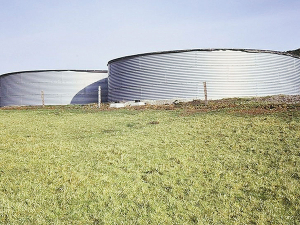With effluent management never far from the thoughts of legislators and farmers becoming increasingly aware of the nutrient values of dairy effluent, innovate ideas for the convenient storage and subsequent discharge are always of interest.
UK effluent specialists Tramspread, based in the south-east of England, has recently introduced a new range of temporary slurry tanks, claimed to be quick to install, in 280, 500,800, 1100 and 1250 cubic metre capacities.
Made in the UK by Butyl Products, the metallic zinc-coated steel is said to last three times as long as standard galvanised steel, is powder coated for a maintenancefree finish and available in any RAL colour. All tanks come with a 10-year warranty (coastal area exclusions apply).
As standard, tanks are equipped with a single 6” through-the-wall filling/ emptying port, but may be specified with multiple ports as required, including 5” up and over the wall layout. Multiple ports allow an umbilical slurry application system to operate, simultaneously drawing-out slurry whilst recirculating back into the tank.
Installation is said to be straightforward, without the need for a concrete base. Instead, the tank uses a compacted earth base covered with a Geotech membrane. A base ring of concrete slabs is supplied as part of the package along with drawings and installation advice.
The tanks can be covered with either a floating Hexa-Cover or a fixed cover, while slurry or digestate can be mixed using a hydraulically driven mixer positioned over the side or agitated using a pump.
A Tramspread spokesman suggests that the flexible tanks lend themselves to several possible scenarios, including being popular as satellite or supplementary stores suitable for existing systems, or perhaps installed to service an outlying block of land or rented ground.
This removes the commitment and substantial investment of a permanent store that might not be appropriate. With no fixed foundations needed the tank can be situated virtually anywhere and uplifted to a new location later.


















